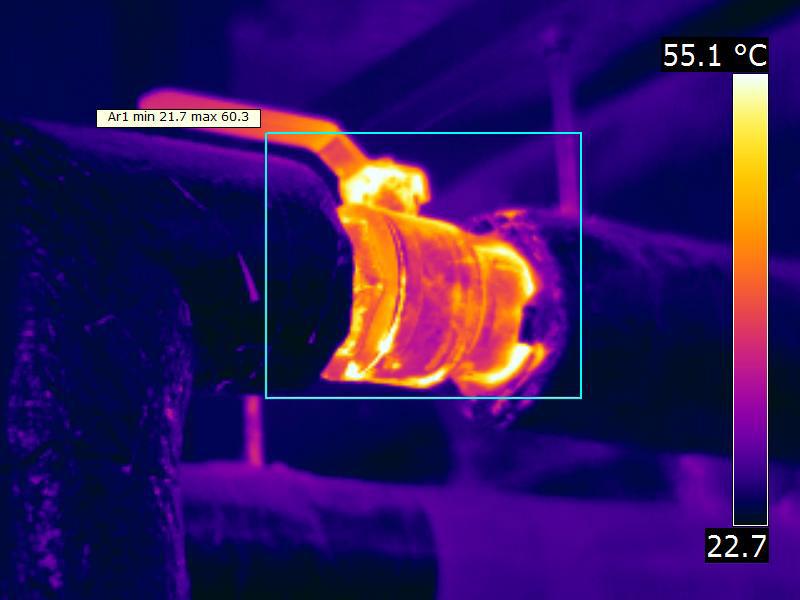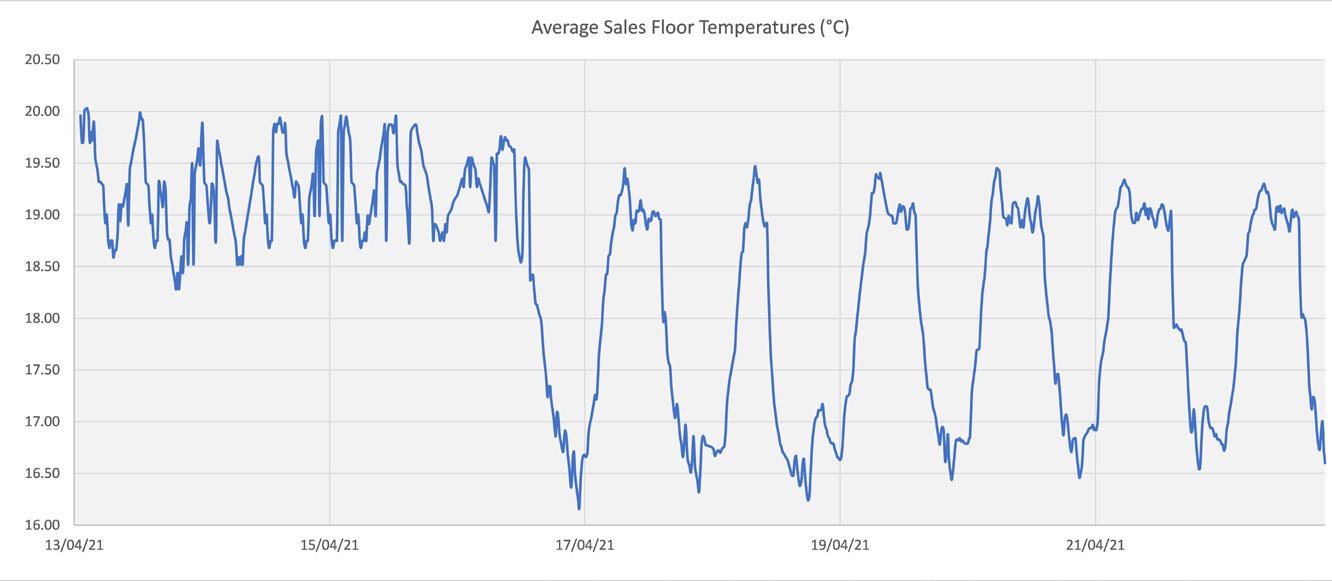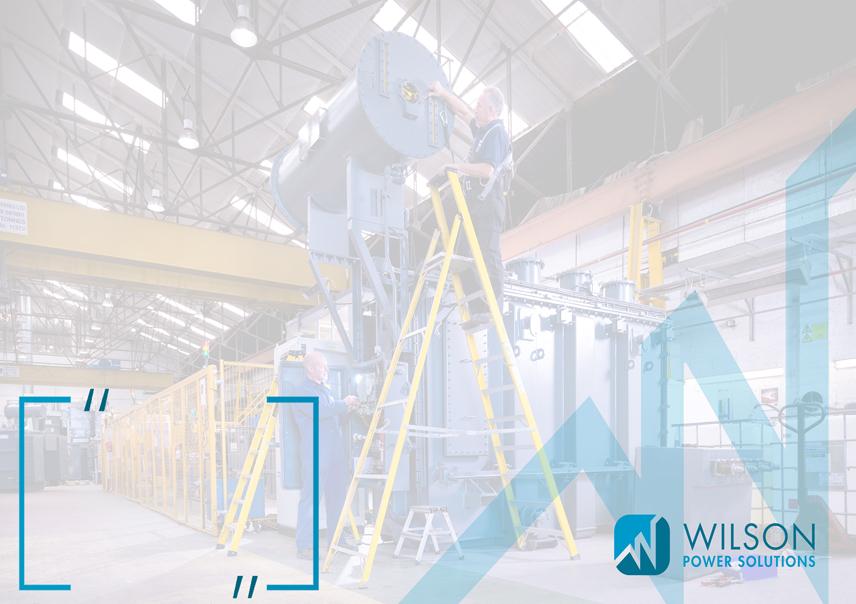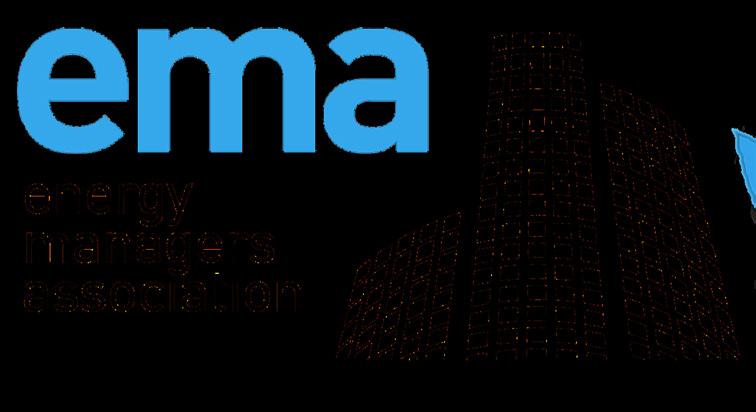
24 minute read
ENERGY EFFICIENCY OPPORTUNITIES IN HVAC

Eliminating energy waste through energy efficiency is something that everyone who looks after energy in their organisation or for their clients is striving for. When it comes to different technologies, there is an endless list of options to consider at every stage. We are looking at different technologies in each issue of The EMA Magazine this year and asking those with experience in these areas for their thoughts and useful tips. In this issue, we will focus on Energy Efficiency Opportunities in HVAC and we have asked three energy management professionals who gave their views in this area.
Advertisement
Andy Watson CEng CIBSE EI, Executive Director at Sim Energy Ltd

Heating Ventilation and Air Conditioning (HVAC) usually represents a high proportion of a building’s energy load, often more than 50% of the aggregate electricity and gas usage. The provision of HVAC is essential to allow occupants to work or reside in relative comfort but due to the fact that its provision is largely invisible (compared to, say, lighting), it is often ignored when it is left switched on even when not required or oversupplying to demands.
For the energy conservation professional this then presents a range of opportunities to make energy savings without resorting to expensive technical upgrades or untested widgets. Here is a selection of some of them.
The most surprising energy efficiency opportunity
Fans, often one of the larger electricity loads in an HVAC system, follow what is called the
cubic power law. This means that the electricity power used by the fan has a relationship to the fan speed by a power of three. For example, if you reduce the fan speed by 50% then the approximate resultant fan power is reduced to: 50% x 50% x 50% = 12.5%.
That means an approximate 87.5% reduction in electrical power. The catch is that fan pressure is reduced according to a square relationship to fan speed so simply running two fans at 50% may not be enough to overcome the system pressure. Nevertheless, finding ways to reduce fan speed will yield significant savings. These methods include CO2 sensing speed control, elimination of leaks, removal of obstructions in the ductwork and airstream etc.
Many energy solutions suppliers have recommended and installed
variable speed drives (VSDs) to clients in the past with a promise to reduce their fan energy costs by 40%. This is a good step forwards, however the first step should be to properly calculate, understand and control your air demand so that a VSD can be automatically controlled, and this kind of energy project optimised.
The no cost energy efficiency opportunity
It would be odd to suggest anything not relating to the Building Management System
(BMS) at this stage. Providing one considers manual expertise on the BMS to be relatively free (an on-site energy manager and BMS maintainer should be able to do this) then focussing on BMS optimisation will yield the shortest paybacks on an HVAC system. Optimisation tasks include:
1. A regular review of time schedules so that the building has enough time to reach the required temperature before occupancy begins but also allowing for the thermal mass and air volume to take some of the demands and the end of the occupancy and shut down HVAC equipment before everyone leaves the building (assuming that occupancy follows a particular schedule). A rough but good first estimate is that if a building takes 1 hour to “warm up” then it takes about 2 hours to “cool down” so you can gain an hour a day of not having the HVAC switched on in many cases. In many cases however, energy experts often find HVAC systems running 24/7 when the building occupancy has nothing like this kind of demand.
2. Optimisation of temperature/ humidity setpoints to provide relatively good control of tempered air. Typically, temperatures between 20-22°C will keep most people happy though this does not account for everyone - sometimes some people will have to wear jumpers while others wear short-sleeved shirts, that’s just human nature and the facilities manager should not react to every single request to increase or decrease the building temperature.
3. Review of Low Temperature Hot
Water (LTHW) and Chilled Water (CHW) temperatures to ensure that while keeping setpoints away from Legionella danger zones, that temperatures are not too hot or cold. The temperature of the service water in comparison to the ambient air dictates the amount of energy wasted through conduction through the pipework and insulation. A rule of thumb is that a one degree relaxation in temperature setpoints will yield a 2% saving in boiler gas usage and a 3% saving in chiller usage.
Furthermore, relaxing setpoints will increase the asset life of chillers and boilers if they are prevented from “hunting” due to poor demand control.


The low cost energy efficiency opportunity
Installers love to insulate straight runs of pipe: it is easy and it looks great when completed.
And they hate fitting insulation over complex shapes such as joints, valves, sensors etc. However, there is more heat radiated and lost from complex shapes than from simple straight pipework. Fitting metallic and fibreglass insulation around these shapes can be tiresome and expensive hence removable jackets are easily and cheaply available to purchase and fit. If access is needed to the ancillaries beneath then the jackets can be quickly and easily removed.
The most common energy efficiency opportunity
It is difficult to imagine a common good approach to HVAC savings though there is a surprisingly high number of cases where instead of some good old-fashioned engineering science has been applied, that some kind of miracle
widget has been invested in. Some of these widgets may work, many do not and if they do then the energy savings yield is often too small to be interesting or the payback period extremely long. It is recommended to always work through the solid engineering techniques before investing in something new and relatively unproved.
The most overlooked energy efficiency opportunity
Many HVAC systems have their fans or pumps arranged in a duty/ standby parallel arrangement.
Often maintainers will cycle these facilities (i.e. switch over which unit is in duty and which in standby) in the belief that this will improve service reliability (in fact this operational strategy is the one most likely to result in simultaneous failure both duty and standby units).
Based on the cubic power law described above, there have been multiple cases where running both duty and standby units simultaneously (using VSDs) has resulted in significant energy savings as well as extending equipment life. This arrangement can be set up with pressure or flow sensors to run up one of the units to 100% of the desired demand if the other fails. I have overseen this improvement at a number of sites with a minimum of 11% electrical saving and a maximum of 36%. If the fans or pumps are already fitted with VSDs then this usually requires a very small amount of controls upgrades to enable this opportunity.
Top Tip
Always examine your actual
system demands first! Does the chilled water temperature really need to be at 6°C when the return temperature is only 7°C? Does all the HVAC have to run at 100% during the occupied period? Is half of the building empty during most of the day?
Typically, HVAC systems are designed to provide for full occupancy at the most extreme of external conditions and then with another 10-20% comfort allowance on top of that. If you are not operating with those conditions then almost certainly you do not need to be running your HVAC at full supply.
Author’s Profile:
Andy has worked and studied in the energy field since 1997 and holds a BEng (Hons) in Energy Engineering as well as Chartered Engineer status. He has been consulting for Sim Energy Ltd since 2006 and has worked for a range of high profile clients in developing carbon and energy mitigation strategies and initiatives. His main focus in the field of energy conservation is using consumption data analysis to develop and optimise solutions.
Sam Arje, Senior Energy Consultant and EnCO Practitioner at TEAM Energy
The most surprising energy efficiency opportunity

Avoiding conflict between heating and cooling units is critical when improving the energy efficiency
of a building. To ensure this, a dead band of at least 3°C must be set. This dead band represents a comfortable building temperature for staff when neither cooling nor heating is required. Many buildings have just 1°C between the two, which is not enough to guarantee that both heating and cooling are not operating simultaneously.
The no cost energy efficiency opportunity
Educating the workforce to understand the importance of
energy efficiency. This will have benefits beyond energy efficiency opportunities for HVAC but by inspiring colleagues to think sustainably will motivate them to be more careful when using HVAC systems.
The immediate benefit is cost saving, and although this seems to benefit the business rather than the employees in the short term, bigger savings means more money within the business to be allocated in different areas.
Demonstrate the business’s position on energy management and the ambition to be a greener, more energy efficient business. In the current climate, customers, suppliers, and future staff respect businesses who are taking climate change seriously so making positive change is great for the company reputation. Most importantly, energy efficient operations drive down energy usage and therefore carbon emissions, which is essential when considering the UK’s net zero target and, for environmental pollution in the local community. This should help them get on board to support your HVAC energy efficiency initiatives. temperature in accordance with the building use can minimise wastage, drive down costs, reduce carbon emissions and enhance overall user comfort. Therefore, it is important to manage HVAC centrally rather than allowing building users access to the controls. Temperature control panels or thermostatic radiator valves could be protected by codes or keys that only limited people have access to.
Additionally, a Building Management System (BMS) can boost the efficiency of an HVAC system by monitoring a building’s humidity and ventilation as well as making it easy to schedule the system to work at different temperatures on specific days and at specific times.
Central temperature and timebased controls will help you to run your operations at the optimal temperature. You may make a bigger impact by utilising zonal controls which are more effective

The low cost energy efficiency opportunity
The nature of a business will determine how its building is used and the ideal temperature it
should operate at. Managing the
where there are multiple uses and required temperatures in different areas.
You could also install placebo controls which look and feel like actual temperature control panels or dials, so users can seemingly adjust settings without affecting your settings. These placebo controls are not connected to the HVAC system so any changes that the user implements on the controls do not affect the building’s optimal settings. Studies have found that often this is enough to make the user believe the heating or cooling has changed in their environment.
The most overlooked energy efficiency opportunity
It is easy to forget the thermostatic settings that run in
the background. Check that they are still suitable for the building’s

The most common energy efficiency opportunity
A physical inspection of areas around the building will help you understand whether your HVAC system is operating in the best
circumstances. Whatever type of building you have, conditioned air is precious so take measures to ensure that roof, wall, and floor insulation is up to standard. operating hours and occupation levels. These are changes that have affected most organisations in the current climate. If there is a control panel, use it as it is meant to be used; adjust time bands, ensure the settings are adapting for seasonality, building use and UK time zone changes. Also check that the dates and times are correct on all control panels.
Additionally, check the building’s temperature sensors, establish that they are calibrated and operating correctly so that the internal heating system switches on and off to suit your organisation’s operating hours. Also check that the sensors are located appropriately, particularly if there have been any changes to the building layouts.
Pipes, ducts, and outlets are also usual suspects for energy loss that can get overlooked. Gaps in windows and doors need to be repaired to improve HVAC efficiency and ensure that external doors are not left open. Where doors are operated by motion sensors, adjust the settings to limit the time they are open for. And, most obvious of all, encourage staff to not be tempted to open windows when the heating is on.
Top tip
Engaging and influencing staff to form sustainable and efficient habits can make a big impact on your building’s
overall energy consumption. It is impossible to make everyone 100% comfortable in a building, but if everyone amends settings to suit themselves, the building is likely to be less comfortable for most and it will never be efficient. Encourage colleagues to adjust their behaviours so they can support the overall energy strategy and avoid inadvertently wasting energy.
It is worth trying to influence organisational dress code to allow staff to dress appropriately for the weather conditions and for their own comfort, suggesting that staff wear layers that they can add or remove accordingly.
Not everyone approaches energy use in the same way, so investing in training to coach colleagues to become more energy conscious and change their habits will be worthwhile.
Author’s Profile:
Sam is Senior Energy Consultant at TEAM Energy. He is an awardwinning Energy Manager with strong experience of implementing energy projects. He is an EMA ESOS Lead Assessor and EnCO Practitioner and specialises in Energy Compliance.
Bruno Valerio, SMaRT hub Energy Analyst at Arcus FM

Introduction
It is known that 160 million buildings in the European Union use over 40% of Europe’s energy and create over 40% of carbon dioxide emissions. In the United Kingdom, direct greenhouse gas (GHG) emissions from buildings were 87 Mt CO2e in 2019, accounting for 17% of the country’s GHG emissions. These emissions are mainly the result of burning fossil fuels for heating. Buildings are responsible for 59% of UK electricity consumption, equivalent to a further 31 Mt CO₂e of indirect emissions.
Therefore, the best practices of sustainable building design, efficient energy management policies, and systems optimisation lead to a significant reduction in energy consumption in buildings, driving the country towards its target of bringing all greenhouse gas emissions to net-zero by 2050.
In retail food stores/buildings, for instance, HVAC electricity consumption accounts for figures between 15% - 25% of total building usage, depending on the heating system design, geographic location of the store, and controls. This type of buildings would also have gas as a fuel type mainly consumed for HVAC purposes, in the event of having their heating & ventilation units gas-fired.
Energy metering systems allow building occupiers, owners, and managers to learn, manage, benchmark, and improve the buildings’ energy performance and ultimately reduce its consumption and subsequent carbon equivalent emissions, by closely monitoring the various equipment circuits & energy loads. In this topic, HVAC sub-metering data is vital for those keen to analyse the building profile, understand internal & external variables affecting consumption & energy conservation in HVAC systems, whilst anticipating trends and detecting anomalies driving the buildings’ energy consumption upwards. The below points represent real case studies of remote energy investigations of HVAC systems.
The most surprising energy efficiency opportunity
Think energy benchmarking and
volume of heated spaces. Energy benchmarks are expressed in terms of delivered energy used per unit of floor area (kWh/m2), for both electrical and fossil fuel energy use. For instance, according to CIBSE Energy Benchmarks TM46 document, the fossil thermal typical benchmark for supermarkets is set at 105 kWh/m2/yr, whereas the electrical benchmark is 400 kWh/m2/yr.
As much as they guide those seeking to understand whether their buildings are or not within the expected consumption intervals, this document failed to consider the differences in thermal energy consumption in the cold and warm months.
Remote energy HVAC assessment in retail food buildings should consider the analysis of building dimensions and other main systems, such as lighting and refrigeration. The over usage of one will affect the performance of others and viceversa.
A particular case of long investigations for a supermarket flagged with excessive HVAC gas consumption has brought up new examples of how one building system can push the other to consume more energy. The investigated supermarket had been within expected energy usage ranges but suddenly seen its gas consumption going through the roof for no apparent reason.
Once the HVAC control strategy had been confirmed to be correct, an engineer has attended the site to investigate the HVAC system operation hoping to determine what could be driving gas consumption massively up. It has been noted that all heating & ventilation units had been working perfectly and in accordance to the customer’s specifications.
However, it has also been noted that the buildings had recently had a lighting investment. The steep increase in gas consumption followed a LED refit not only because these type of bulbs emit less heat but also, and more importantly, the previously dropped ceiling holding the older lighting system had been removed which has almost doubled the heated space and, therefore, heating demand. The HVAC system was
eventually replaced by a more efficient alternative to match the new heating requirements.
Although energy benchmarks add valuable information regarding the typical energy use assessment for a certain building type/sector, it is advised to analyse other parameters that would help to identify energy efficiency opportunities in HVAC.
The no cost energy efficiency opportunity

Set energy alerts. One of the key steps of building optimisation is the extensive remote analysis exercise, which could be taken as a first assessment before an on-site energy HVAC audit or purely to ensure these systems run smoothly from an operation & energy efficiency point of view, and in line with the Federation of European HVAC Association’s (REHVA) guidelines.
An analysis of metering data does highlight what is very likely to be missed during on-site audits. The better the data granularity available the higher the chances of spotting anomalies. The combination of energy metering data with telemetry data as well as site operating hours provides an efficient and no-cost way to spot anomalies that could progressively become asset problems or simply detect tiny deviations to the expected building HVAC energy consumption profile. As a result, small and quick remote adjustments could easily result in achieving energy savings by simply resetting BMS systems to specifications. Such a task could be carried out by adjusting BMS parameters in line with core operating hours, building occupancy demands, and/ or seasonal weather factors.
The below pictures represent the reduction of a retail building sales
floor temperatures following the BMS remote adjustments and the direct gas consumption drop, respectively.
As per this adjustment, not only has a gas reduction been achieved, but also the HVAC electricity consumption is likely to have reduced. Furthermore, in food retail buildings, we often witness indirect refrigeration energy savings too, depending on how much the heat load is eased upon these systems.
As BMS systems automatically run all year round, they help reduce business costs and lower carbon emissions by requiring little maintenance and assuring building thermal comfort, achieving superb savings at no cost. If the building’s energy tariffs are also known and the BMS systems are capable of adjusting settings in a relatively quick period, then an even bigger energy-saving opportunity can arise.
Peak tariff management represents a real advantage where, for example, the reduction of major HVAC units’ motors speed or even their temporary shutdown occurs during high energy tariff events (such as Triads) avoiding, at times, the payment of astronomical energy bills.
The low cost energy efficiency opportunity
Explore maintenance visits.
HVAC systems, like any other building systems, do require regular maintenance. Ultimately, this contributes to fewer repair costs, avoiding major asset issues, increase

equipment lifespan and indoor air quality as well energy efficiency.
Planned preventive maintenance (PPM) visits play a vital part in identifying poor asset performance and retaining these at the desired level of quality. Therefore, including HVAC energy checks in these visits does help pinpoint essential equipment components that could potentially be outdated or requiring replacement.
Frequently, sites with excessive gas and HVAC electricity consumption do show some sort of overused asset parts, particularly on occasions where the BMS strategy has been reviewed and set to specification. For instance, the replacement of an Air Handling Unit (AHU) filter and/or door curtains have saved significant amounts of energy in food retail buildings, not to mention the health & safety benefits that come with it.
To make the most of PPM visits and adequately plan these according to each building’s demands, geographical location, and/or season, could add great benefits by minimising the HVAC system energy consumption and extending its lifespan.
Review settings. Particularly during the winter months, HVAC systems seem to stretch their capabilities and require pre-winter maintenance checks followed by permanent energy performance monitoring. By doing so, not only do we ensure consumption is within expected ranges but also building thermal comfort is delivered. Thus, and as previously mentioned, the correlation between telemetry data (building temperatures, AHU supply temperatures, heating demand, etc) and energy metering provides a great remote overview of sites’ energy & thermal performance.
Commonly, retail food supermarkets are flagged with excessive HVAC & gas consumption. Several factors contribute to this but perhaps the requirement to run systems above standard specifications and longer than core operating hours represents the main drivers for such a fuel consumption increase.
Despite BMS systems running automatically, faults do occur causing for example, loss of communications to sites and leaving the major HVAC units running flat out. Settings need to be reviewed once communications issues are rectified and/or according to building operations’ demands.
Furthermore, ensure settings are also reviewed post-on-site works as these could easily be misleading HVAC units to run harder than needed (quite often unnoticeably until energy consumption starts climbing) and most importantly, that the BMS strategy is in line with the building’s demands. This could provide quick wins, not requiring site attendance and maintaining sites within their energy budgets.
Top tip
There are no equal buildings.
Be mindful of the fact that each building is a different case scenario as its energy demands, fabric properties, installation type, or simply BMS control strategy may well be different from its most similar site. Consequently, the search for energy efficiency opportunities, particularly from a remote perspective, does require deep investigations, merging several layers of data that would normally pay off the invested time.
As faults do normally occur, the trick is to closely monitor, continuously assess energy and asset performance and, if possible, work with live data to predict rather than react. Owners and tenants also carry out investment programs and on-site works which require energy baselines to be adapted and any BMS strategy amended accordingly.
Adopt a bespoke Energy Management Policy which, coupled with a proactive colleague and staff behaviour, becomes vital to follow good practices and helpful in spotting anomalies. Invest in replacement of inefficient systems by low carbon technologies to minimise fuel consumption and GHG emissions.
Lastly, keep your eyes wide open and rigorously pay attention to detail (i.e. on data) as it does make a clear difference. The planet thanks us for any energy efficiency improvements.
Author’s Profile:
Bruno is passionate about Energy & Environment and working towards the net-zero target. Awarded with a Master’s degree in Energy & Bioenergy, he joined Arcus in 2015 to perform energy consultancy, analysis, management, and monitoring for our customers, supporting them to reduce their energy consumption and carbon footprint.
ENERGY MANAGEMENT ONLINE TRAINING SCHEDULE 2021
Energy Management Theory Combined with Real-World Applications
JULY
1st SECR Compliance 9th Net Zero Fundamentals and Strategies
SEPTEMBER
17th Reaching Net Zero 23rd Energy Auditing Techniques 24th Energy Monitoring, Targeting and Validation 30th-1st OCT Fundamentals of Energy Management
OCTOBER
15th On-site Electricity Generation 21st BMS Essentials, Controls and Optimisation
NOVEMBER
4th Turning Data into Energy Savings 5th Lighting – Basic Understanding 11th Understanding and Delivering Behavioural Change Programme 12th Essential HVAC Control and Optimisation 19th Waste Management
DECEMBER
3rd Lighting – Basic Understanding
REDUCED PRICES
Group Training
All courses can be delivered to teams or groups of stakeholders from the same organisation or industry in a standard format, or as tailored sessions (minimum 6 candidates). For a quote email jana.skodlova@ theema.org.uk with your chosen course title and approximate number of staff. We can also develop new, bespoke material to fit specific client needs.
For an up-to-date list of all our courses visit our website at www.theema.org.uk
“The course built on all aspects of previous knowledge and added a potential new skill that I did not have before attendance.”
Energy & Environmental Manager - Celtic Manor Collection
“It was informative, useful and given confidence to challenge quotes and suppliers.”
Energy Efficiency Manager - Parkwood Leisure

We can design, manufacture and install power transformers for your projects
We build and supply CRGO double wound power transformers up to 200MVA Transformers are manufactured in accordance with international standards Tier 2 EU Ecodesign compliAnt




















enquire now on: 0113 271 7588 or info@wilsonpowersolutions.co.uk More details on the website: www.wilsonpowersolutions.co.uk
24 month guarantee



TOPICAL
CPD awarded Practical advice Q&A sessions

14 April 2021 DECARBONISATION OF HEAT – THE BASICS OF HEAT PUMPS
Decarbonising heat is key to achieving Net Zero. This workshop will look at the basics of heat pump deployment and use and discuss where heat pumps can and should be used and how to make sure their use is optimised. The session will also look at some of the common problems that occur with heat pumps.
5 May 2021 TRANSPORT DECARBONISATION TECHNOLOGIES: PROS & CONS
This workshop will look at the range of technologies available to decarbonise the transport and discuss their impact and advantages and disadvantages. The session will look at the following technologies: biomethane, H2ICE, H2FC and battery.
7 July 2021 ENERGY CHAMPIONS – ROLES, RESPONSIBILITIES & ENGAGEMENT
Appointing energy champions is a great way to support the promotion of energy and water efficiency throughout an organisation and to encourage employees to adopt sustainable measures in the workplace and at home. This workshop will look at the champions’ roles, responsibilities and the support they require to be effective and a good resource within the organisation.
SUBSCRIPTION AVAILABLE
MEMBERSHIP
Packages of 10, 20 and 30 Prices from £150+VAT Packages of 10, 20 and 30 Prices from £300+VAT




